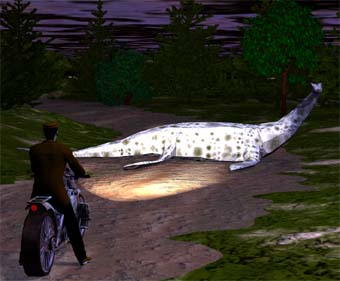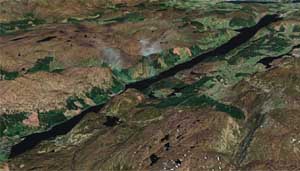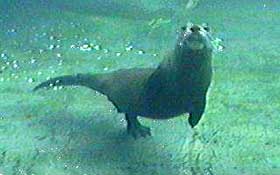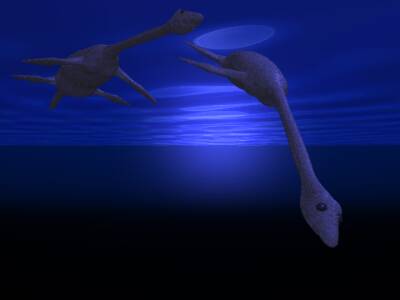pop up description layer
HOME
Cryptozoology UFO Mysteries Aviation Space & Time Dinosaurs Geology Archaeology Exploration 7 Wonders Surprising Science Troubled History Library Laboratory Attic Theater Store Index/Site Map Cyclorama
Search the Site: |
|
The Great Glenn is an enormous gash in the earth that splits the Scottish Highlands in two. It forms a chain of rivers, canals and lakes, (or lochs), that connect the North Sea with the Atlantic Ocean. One of these lakes, Loch Ness, is the home of perhaps the most famous cryptozoological riddles of our time. Loch Ness, the largest freshwater lake in the British Isles, is twenty four miles long and, at one point, one and a half miles wide. It has an average depth of four hundred and fifty feet and at times plunges close to a thousand. It is cold and murky, with dangerous currents. In short, it is the perfect place to hide a monster from even the most prying eyes of science. Many bodies of water in Northern Scotland have ancient legends about monsters that were never written down. A tale that supposedly occured in 565 A.D. tells of Saint Columba who saved a swimmer from a hungry monster in the Ness river. This story was recorded in the book The Life of Saint Columba sometime in the late 7th Century and is often connected with later sightings in the in the nearby lake. Modern Sightings In 1933 after a new road was built along the edge of the Loch, the number of reports soared. The first of these came on April 14 when the owners of an inn in Drumnadrochit, the Mackays, observed an "enormous animal "rolling and plunging" in the Loch. They reported itto Alex Campbel, the man in charge of regulating salmon fishing in the Loch. Campbel spent a lot of time at the lake and observed the monster himself several times after being told of the Mackay sighting. Campbel described the creature as having "a long, tapering neck, about 6 feet long, and a smallish head with a serpentine look about it, and a huge hump behind..." Campbel estimated the length of the "monster" to be about thirty feet. The first photograph of the thing was taken in 1933 by Hugh Gray. Gray reported, "I immediately got my camera ready and snapped the object which was then two to three feet above the surface of the water. I did not see any head, for what I took to be the front parts were under the water, but there was considerable movement from what seemed to be the tail." Probably the most famous picture of the Loch Ness monster was the "surgeon's photo" supposedly taken by Colonel Robert Wilson in 1934. It shows a long, thin neck rising above the water connected to a hump-like body. This photo is thought to be a fake, though, after the confession of Christian Spurling who helped build the model monster that was photographed. He admitted the hoax shortly before he died in 1993 at age 90.
Early in 1934 there was a land sighting of the beast. Arthur Grant, a young veterinary student, was out on his motorcycle one evening when he almost ran into the monster as it crossed the road. Grant's description of the thing, small head, long tapering neck and tail with a bulky body and flippers, seemed to match the appearance of the plesiosaurus. The plesiosaurus, an aquatic, reptilian contemporary of the dinosaurs, was thought to have been extinct for at least 65 million years. In April of 1960, Tim Dinsdale, while visiting the lake, captured the first moving picture of the monster. Though the film shows little, a group of Royal Air Force photographic experts pronounced that the object was "probably" animate and as long as ninety feet. Skeptics argued that the thing was probably a motorboat. Dinsdale was convinced enough by his own pictures to give up his career as an aeronautical engineer and devote the next twenty years of his life to finding the monster. Though Dinsdale was rewarded with two more sightings of the creature, he was never able to gather incontrovertible proof of its existence. Rines' Photographs The next major event for Nessie was a study of the Loch Monster started in 1970 by the American Academy of Applied Science. The group, headed by Dr. Robert Rines, used automatic cameras and sonar to monitor the Loch. In 1972 one of the underwater cameras got four frames of what appeared to be a flipper six to eight feet long. One night Peter Davies, a member of Rines' team, was out in a small boat in the Loch when he had a close encounter with the beast. He detected it under his boat with sonar. "I don't mind telling you it was a rather strange feeling," said Davies, "rowing across that pitch black water knowing that there was a very large animal just thirty feet below. It was the sheer size of the echo trace that was frightening." Though the photograph most often seen by the public seems to clearly show something that looks like the diamond-shaped fin of a plesiosaurus, some photographic experts have argued that the image has been retouched. In the original images the interpretation is much more ambiguous. In 1975 one of the team's cameras captured a vague and fuzzy image that could be interpreted as the face of the beast. "I thought that would clinch it," remarked Rines," but as you know, it didn't at all." The photograph, known as the "gargoyle head," was identified by a later expedition as the remains of a tree stump.
Sonar Searches Various researchers have employed sonar to find the monster with varying results. In 1968 professor DG Tucker of the University of Birmingham tested a prototype sonar at the Loch. The transducer was mounted at one side of the lake, pointing at the opposite side so that any objects passing through its beam would be detected. During a two-week period, multiple animate objects 20 feet in length were detected moving up and down from the loch bottom to midwater, but never surfacing. The size and movement did not seem to match that of any known fish. Tucker even declared, "The high rate of ascent and descent makes it seem very unlikely that they could be fish, and fishery biologists we have consulted cannot suggest what fish they might be. It is a temptation to suppose they might be the fabulous Loch Ness monsters, now observed for the first time in their underwater activities!" A year later Andrew Carroll, a researcher for the New York Aquarium used sonar from his research launch Rangitea to sweep the Loch and picked up a strong echo of an animate object estimated to be twenty feet in length. Neither object found by Carroll or by Tucker were ever definitely identified. Roy Mackal, a biologist at the University of Chicago who was interested in cryptozoology, built a system of underwater microphones and placed them in the loch to see if he could detect any sounds the monster might make. "Bird-like chirps", "knocks" and "clicks" were recorded along with a swishing sound which Mackal thought might be the sounds of an animal echolocation to find and hunt its prey. Mackal noted that the sounds stopped whenever a boat passed by and resumed after it had reached a safe distance. The most recent sonar exploration of the Loch was in 2004 when an expedition from the BBC used 600 sonar beams to probe the Loch from end-to-end. They could detect no sign of a large living animal in its waters. Efforts have continued to find the monster. A small submarine was even used to explore the depths of the lake, but no convincing evidence was found.
A Breeding Population There is certainly not a single Loch Ness monster. If there truly is something strange living in the lake there must be a breeding population, perhaps anywhere from a dozen to a hundred individuals. There are a few photographs which seem to show more than one of the creatures together. If there really is a population of monsters in Loch Ness, what are they? Some of the evidence, like the vet student's sighting, point to the plesiosaur. Mackal has suggested a large mammal like a manatee or a zeuglodon (primitive whale). Others suggest an unknown species of long-necked seal or giant otter. Earlier, Mackal also considered it might be a giant sea slug. A few researchers suggest an over grown eel. Skeptics argue that the water in the Loch is too cold for a reptile like the plesiosaur though recent studies suggest that some dinosaurs, and therefore perhaps the Plesiosaur, were warm-blooded. They also argue an air-breathing animal like a plesiosaur or even a whale or seal would spend much more time on the surface than this creature seems to and would be spotted more often. Any population of warm-blooded creatures would also require a large food source. The fish population in the Loch, while larger than originally thought, still seems inadequate to support a large group of warm-blooded predators. Non-animal Explanations Some scientists have wondered if the sightings might be caused by an underwater wave which is known to sometimes occur in deep, long, cold lakes, like Loch Ness. Standing waves, also known as seiche, can be caused by the wind piling up a layer of warm water at the end of the loch which forces the underlying cold layer to the opposite end. The wave is not visible on the surface, but moves underwater with the interaction of the layers. Such a wave might be powerful enough to push debris to the surface that might look like a strange animal. Another theory forwarded by Dr Maurice Burton suggests that logs of scotch pine that have fallen into the lake may decay, creating gas inside the wood which cannot initially escape because the resin in the bark seals it in. As the pressure builds, however, the seal can rupture, propelling the log through the water and even to the surface. This may account for some of the sightings. Hoaxes Unfortunately, the history of the Loch Ness monster is filled with people creating hoaxes. In 1933, Marmaduke Wetherell, who himself was thought to be responsible for the famous Surgeon's Photo hoax, was himself hoaxed when he found the footprint of a large animal in the mud along the shore of Loch Ness. The mark was created using a dried hippo foot that was probably part of an umbrella stand. The incident, reported in the Daily Mail, humiliated Wetherell, who later got his revenge when his fake "Surgeon's Photo" appeared in that same publication. One of the clearest photos of the Loch Ness monster was taken by Anthony 'Doc' Shiels in May of 1977. The picture is so clear, however, it immediately makes experts skeptical and has been referred to in some circles as "the Loch Ness Muppet." Shiels himself, a self-styled physic, has said that while he definitely takes photos of lake monsters, he doesn't believe in them. As recently as March, 2005, two American students visiting the Loch claimed to have found a gigantic tooth stuck in the carcass of a deer. However, the object was actually the antler of a roe muntjac deer, not a Nessie fang. The whole story turned out to be a marketing ploy for an upcoming horror novel entitled The Loch, written by author Steve Alten. Nessie has entered popular culture and is a symbol recognized around the world. In addition to appearing in Alten's book, Nessie has been featured in many films. This includes appearances as dangerous killer in The Loch Ness Horror (though in reality nobody has ever claimed they have been injured by the creatures), a secret submarine in the film The Private Life of Sherlock Holmes and, most recently, a child's magical friend in The Water Horse: Legend of the Deep.
If the monster truly exists and is not a hoax or a publicity stunt, it is extremely elusive. No bones or remains have ever been, found and short of draining the Loch, it seems impossible to disprove the existence of the creature. We can only wait and see if time and patience, with a little luck, solves this most mysterious riddle. Copyright Lee Krystek 1996-2007. All Rights Reserved.
|
|
Related Links |
|
|







